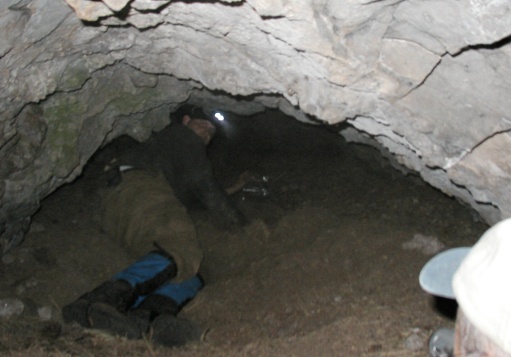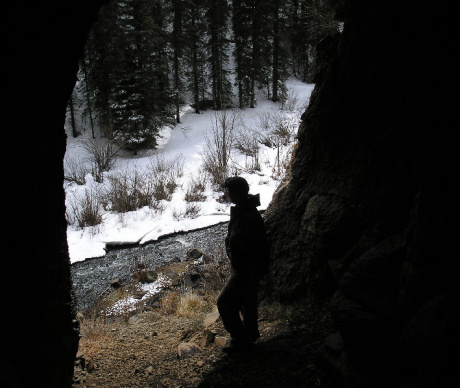|

Isaac Bailey (commerical photograher from Phoenix, Arizona) lies on the
mass of soft grass bedding in the rear of the cave he discovered during
the BFRO's first Arizona Expedition (April, 2006).
Isaac found the cave below the lip of an 8000 foot plateau, near where
a retired Phoenix police officer and his wife reported seeing a sasquatch
walking down a mountainside in July 2005. That incident was reported to
local rangers immediately after it happened. The rangers investigated
the area on the following day, and found, and cast, 20" sasquatch
tracks, which they showed to some of the expedition guides.
The casts and circumstances were impressive enough for the expedition
group to focus on this portion of the Mogollon Rim during the expedition.
In the photo Isaac is seen lying on the soft grass bedding that covered
the floor of the rear half of the cave. The bedding covered an area the
size of 3-4 king size beds. The grassy bedding was soft and comfortable,
and was roughly 1 foot deep from wall to wall.
This cave is nearly 40 feet deep, 10 feet wide, and 7 feet high at the
entrance. It tapers quickly to a height of 4 feet and maintains that height
nearly to the back of the cave.
This cave was not created by the flow of water, and it is distinctly not a lava tube.
Both the floor of this cave and the roof of this cave were noticeably
different from other cave/overhang formations in the same strata along
the canyon rim. As noted by a geologist attending the expedition, the
floors of the other caves/overhangs along the canyon were covered with
jagged rocks that had fallen from the ceiling. By striking contrast, in
this cave, dirt had been brought in and spread across the floor, filling
in the gaps between the jagged rocks, to make the floor flat and easier
to crawl across. Some large rocks had been moved to the sides to create
a crawl channel for the first 20 feet or so.
The ceilings of the other caves/overhangs under this plateau rim showed
the flat, natural contours of the rock layers. Whereas, this cave had
a gouged, arched ceiling. Most of the protruding pieces of rock had been
systematically chipped off the ceiling at some point in the past.
The ceiling was not shaped by the forces of erosion. Nor was it created
by miners. Shafts created by miners are easy to identify. The rock walls
of mines inevitably show markings of the tools used to pick or bore through the
rock. The walls of this cave showed no such markings.
The rock layer of the plateau was not
solid. It was fractured rock that could be chipped away in chunks by pounding against it with another rock.
_______________________________________________________________
Why go to the trouble of chipping out a cave when other, naturally formed,
cave-like overhangs were less than a quarter mile away?
Possible answer: Not far from the entrance of the cave there are rock
outcroppings that afford a commanding view of the confluence of three
canyons used by migrating elk herds.

|
A different cave in the upper portion of the same canyon as Isaac's
cave.
This other cave was different in several respects from Isaac's
cave.
A few of the differences:
- It was clearly formed by natural erosion.
- It was more exposed to view from the creek below.
- It did not have a commanding view of the confluence of elk canyons.
- There was nothing inside to suggest that was used for habitation
by anything.
This photo taken on the second day of the BFRO's 2006 Arizona
expedition by Jerry Hermann (BFRO - Oklahoma).
|
__________________________________________________________
In Isaac Bailey cave there was nothing to suggest human use, ever. There
was no writing on the rock walls, no trash, no evidence of fire, either
inside or anywhere around the cave. There was no carbon soot on the walls.
The total lack of carbon soot indicated that it was probably never used
by native Americans. Fire soot on a dry cave ceiling will remain for hundreds
of years, if not thousands of years.
There were no bones in the cave.
A few bags of the grass bedding were removed from the cave
and will be examined for hairs by an accomplished paleontologist from
north-central New Mexico who attended the expedition.
We suspect the cave is used mainly in the warmer months. It was above
the snow line in early April. There was no indication of current usage
in early April, and it is situated below the lip of a plateau that is
frequented by large herds of elk in the summer, when the grass is plentiful.
A professional wildlife biologist from northeast Arizona examined the
cave. She concurred that the bedding appeared to be prepared by something
with hands, and not gathered by any known animal, including bears or wood
rats. She elborated on the differences between this accumulation of grass
and a wood rat's nest.
_______________________________________________________________
The cave overlooks a canyon. Across the canyon there is a vantage point
that will allow for monitoring of the cave with telephoto lenses in the
summer.
Those who participated in this expedition are encouraged to coordinate
periodic monitoring of this cave, from a safe distance, during the summer.
_________________________________________
You are invited to attend the upcoming
BFRO Expeditions.
|























